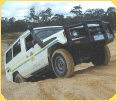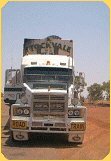 |
 |
|
|
|
||
|
Outback Info (Private Seiten) © seit 1999 Two Peoples Bay
Like Waychinicup National Park, Two Peoples Bay boasts unspoilt coastal scenery and is a vital area for threatened animal species. Two Peoples Bay, which faces due east, lies between the granite massifs of Mount Gardner and Mount Manypeaks, near Albany. The high rocky hills around Mount Gardner form a headland on the south side of the bay, protecting it from the heavy Southern Ocean swells. Midshipman Ransonnet would have appreciated the contrast with the rugged open sea around the headland when he brought his exploration party into the sheltered waters of Two Peoples Bay in 1803. They had left Captain Baudin's ship the Géographe at Frenchman's Bay, and sailed east to explore the then uncharted area. To their surprise, they found Captain Pendleton in the United States brig Union, already there. The Union had come from New York in search of seals. The French and American meeting on the far side of the world was commemorated in the name Baie de Deux Peuples. In later years, others came to exploit the marine life on the South Coast of Western Australia. In the 1840s, up to 12 ships anchored in Two Peoples Bay during the whaling season, to hunt humpback and southern right whales in the bay and surrounding waters. Whale blubber was rendered on the ships and onshore. Today, winter storms sometimes expose whale bones along the beach - bleached reminders of a grisly, dangerous trade. The Noisy Scrub-bird
A small brown bird was first brought to the attention of science through John Gould's lavishly illustrated Birds of Australia, published in England in 1845. John Gilbert, his collector in Western Australia, had supplied the specimens. Gould originally named this new species the noisy brush-bird (Atrichornis clamosus, the "loud bird without bristles"). It has unusually small rounded wings, a strong muscular body and a very loud voice (according to Gilbert, it was the loudest of all the songbirds he knew, and the most difficult to obtain as a specimen). And, unlike all other song birds, it had no wishbone. Its relationships with other birds were a mystery. Gould predicted that a study of the noisy scrub-bird -- as he renamed it -- would yield "highly interesting information respecting the economy and history of this curious form". He also predicted that it would rarely "meet the gaze of civilised man". Indeed, the opportunity for scientific study receded rapidly. In the next 50 years, only two more specimens arrived in Europe, and only a handful more were taken for Australian museums. The bird became increasingly difficult to find. After the turn of the century, searches were made throughout the south-west by many ornithologists. They all proved fruitless, and scientists began to fear the bird was extinct. Rediscovered The noisy scrub-bird could no longer be found in the Augusta-Margaret River area, or in the hills near Waroona, where Gilbert had first seen it, nor around Albany, where several specimens had been obtained last century. But it was not extinct. The bird's wariness and brown plumage make it virtually invisible in the dark, impenetrable scrub. Almost flightless, it keeps to the densest vegetation, moving like a small, fleeting shadow through the undergrowth. Only the resonant, musical song of the territorial male gives his location away. This song led John Gilbert to discover the noisy scrub-bird in 1842, and the same song drew Harley Webster, an Albany school teacher, into the scrub at Two Peoples Bay late in 1961. At the foot of a mountain, he saw a bird that, despite years of bird-watching in the south-west, he had never seen before. Shortly afterwards, in February 1962, a small remnant population was found inhabiting the gullies of Mount Gardner. In all the world there remained only about 100 individuals, confined to one small area on the edge of the Southern Ocean. This rediscovery gained international publicity. Local, national and international conservationists worked hard to stop residential developments planned for the area, and to protect the bird's habitat. Two Peoples Bay Nature Reserve was formally gazetted in 1967 and covered the entire headland, the adjacent islands and the short isthmus connecting to a wetland system of lakes, streams and swamps -- remnants of an estuary in the Pleistocene era. All of the known noisy scrub-bird habitat was included, giving the reserve a diverse array of vegetation types suitable for many other species. Research into the noisy scrub-bird showed that the bird was sensitive to fire and needed dense, long-unburnt scrub with a well-developed leaf-litter fauna. In fact, it was probably the change in fire regimes, grazing and clearing of habitat following European colonisation that had brought the bird so close to extinction. From the early 1970s, the reserve was managed to exclude fire and, in response, scrub-bird numbers began to increase. By the end of the 1970s, the population had grown sufficiently to contemplate creating other populations outside Two Peoples Bay Nature Reserve. If it was confined to a single population, there could never be much of a future for the scrub-bird. The amount of habitat within the reserve is limited, and the population would always be vulnerable to wildfires. Colonising new areas outside the nature reserve would be a slow process for the flightless bird. To spread, it needs corridors of continuous scrub connecting breeding areas to vacant habitat. It also needs many breeding seasons to produce a supply of dispersing birds. Since 1983, noisy scrub-birds from Two Peoples Bay have been released in several places east of Albany. When released into good habitat that is protected from fire, the birds breed and their offspring gradually colonise all the available habitat. In this way the total number of noisy scrub-birds has increased tenfold since its rediscovery, and the population is now spread along almost 50 kilometres of the coast around Two Peoples Bay. Other Birds Two Peoples Bay is unusually rich in birds, with 188 species recorded there. Some of these are seabirds, like the great-winged petrels, flesh-footed shearwaters and little penguins, which breed on Coffin Island. Others are transequatorial waders or nomadic species of honeyeaters, lorikeets and pardalotes, which appear in response to seasonal blossom. The majority, however, are residents that breed within the reserve. Like the noisy scrub-bird, some also face problems of low numbers and reduced ranges. The western bristlebird (Dasyornis longirostris) is found in the dense heaths on the sandy slopes of Mount Gardner, and is currently designated an endangered species. So is the western whipbird (Psophodes nigrogularis nigrogularis -- Two Peoples Bay subspecies), an inhabitant of the scrubby thickets. Both birds had ranged as far north as the Perth area, where John Gilbert recorded them last century. He thought of these and the noisy scrub-bird as forming a trio of "allied" species, because of their similar habits and the fact that they seemed to inhabit the same areas. By the middle of this century, their ranges had contracted to the Two Peoples Bay area, and their numbers around the time the nature reserve was created were very low. Thanks to habitat protection within the reserve and surrounding areas, the numbers of western bristlebirds and western whipbirds have increased during the last two decades, and their populations are now also spread north and east of the Bay. Mammals
The bay is also a haven for a number of rare and uncommon mammals. The diggings of the quenda are common -- at times, areas particularly favoured by these omnivorous bandicoots resemble newly dug-over vegetable gardens. Quendas are often seen during the day crossing roads and tracks within the reserve, and are taken by birds of prey such as the little eagle. Western ringtail possums are occasionally seen in the low forest trees on Mount Gardner, where their dreys (basketball-sized nests made of sticks) are common. For many years, the population of quokkas on Mount Gardner was one of few known on the mainland. These small mammals make tunnel-like runs through thick vegetation. Seldom seen in the thick cover, the runs and their distinctive droppings are often the only sign of their presence. The numbers of quenda, ringtail possum and quokka, judging by sightings, tracks and droppings, also appear to be increasing as the fox control program takes effect. The most exciting and least expected spin-off from the conservation of the noisy scrub-bird came in late 1994, when a small, rabbit-sized marsupial called Gilbert's potoroo (Potorous gilbertii) was found on the slopes of Mount Gardner. This animal -- also originally brought to the world's attention by John Gilbert -- had not been reliably reported anywhere in the south-west for more than 100 years, and had been officially proclaimed extinct. Gilbert's potoroo is the fourth of John Gilbert's discoveries that disappeared from view, only to be found again at Two Peoples Bay. Potoroos specialise in eating underground fungi, and this nocturnal and appealing little animal had been quietly going about its truffle-hunting business beneath the Mount Gardner scrub, unseen for many years. But it must have come very close to extinction. Despite intensive efforts, only 15 individuals were captured in the first year after rediscovery. The search is continuing. Two Peoples Bay is now a virtual mecca for international visitors with a special interest in birds, most of whom want to try their luck at sighting one of the area's famous rarities. THINGS YOU NEED TO KNOW
Where is it? Travelling time: What to do:
Facilities: Best season:
|
Schatzsuche in Down Under / Fossicking
|
||||||||||||||||||||||||||||||||||||||||||||||||||||||||||||||||||||||||||||||||||||||||||||||||||||||||||||||||||||||||||||||||||||||||||||||||||||||||||||||||||||||||||||||||||||||||||||||||||||||||||||||||||||||||||||||||||||||||||||||||||||||||||||||||||||||||||
Australien-Kanal.de © seit 1999, Fossicking.de © seit 1999




